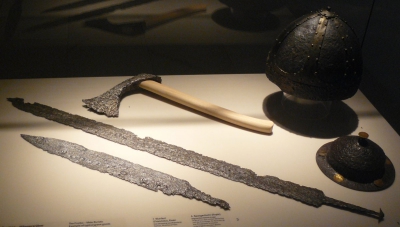The Battle of Vzeronce took place on June 25, 524 near Vzeronce-Curtin (then Veseruntia) in Isre, France. This battle was part of an invasion of Burgundy initiated by the four successors of the Frankish king Clovis I: Childebert I, Chlodomer, Chlothar I, and Theuderic I.
The previous Burgundian king, Sigismund, had been executed by the Franks, and was succeeded by his brother Godomar. Godomar led the Burgundian army and inflicted a severe defeat on the Franks, with Chlodomer killed during the fighting. However, the defeat of the Franks was only temporary and the kingdom was lost to the Merovingians within a decade.
A helmet was found in the peat marsh of Saint-Didier, to the north of the battle site in 1871 and is conserved in the Muse dauphinois, Grenoble. The helmet is of Byzantine craftsmanship and was probably that of a Frankish chieftain.
The Franks (Latin: Franci or gens Francorum) were a group of Germanic peoples whose name was first mentioned in 3rd-century Roman sources, and associated with tribes between the Lower Rhine and the Ems River, on the edge of the Roman Empire. Later the term was associated with Romanized Germanic dynasties within the collapsing Western Roman Empire, who eventually commanded the whole region between the rivers Loire and Rhine. They imposed power over many other post-Roman kingdoms and Germanic peoples. Beginning with Charlemagne in 800, Frankish rulers were given recognition by the Catholic Church as successors to the old rulers of the Western Roman Empire.Although the Frankish name does not appear until the 3rd century, at least some of the original Frankish tribes had long been known to the Romans under their own names, both as allies providing soldiers, and as enemies. The new name first appears when the Romans and their allies were losing control of the Rhine region. The Franks were first reported as working together to raid Roman territory. However, from the beginning, the Franks also suffered attacks upon them from outside their frontier area, by the Saxons, for example, and as frontier tribes they desired to move into Roman territory, with which they had had centuries of close contact.
The Germanic tribes which formed the Frankish federation in Late Antiquity are associated with the Weser-Rhine Germanic/Istvaeonic cultural-linguistic grouping.Frankish peoples inside Rome's frontier on the Rhine river included the Salian Franks who from their first appearance were permitted to live in Roman territory, and the Ripuarian or Rhineland Franks who, after many attempts, eventually conquered the Roman frontier city of Cologne and took control of the left bank of the Rhine. Later, in a period of factional conflict in the 450s and 460s, Childeric I, a Frank, was one of several military leaders commanding Roman forces with various ethnic affiliations in Roman Gaul (roughly modern France). Childeric and his son Clovis I faced competition from the Roman Aegidius as competitor for the "kingship" of the Franks associated with the Roman Loire forces. (According to Gregory of Tours, Aegidius held the kingship of the Franks for 8 years while Childeric was in exile.) This new type of kingship, perhaps inspired by Alaric I, represents the start of the Merovingian dynasty which succeeded in conquering most of Gaul in the 6th century, as well as establishing its leadership over all the Frankish kingdoms on the Rhine frontier. It was on the basis of this Merovingian empire that the resurgent Carolingians eventually came to be seen as the new Emperors of Western Europe in 800.
The terms "Frank" or "Frankish" subsequently developed several different levels, sometimes representing a very large part of Europe, and on the other hand sometimes limited to France. In the High and Late Middle Ages, Western Europeans shared their allegiance to the Roman Catholic Church and worked as allies in the Crusades beyond Europe in the Levant. In 1099, the crusader population of Jerusalem mostly comprised French settlers who, at the time, were still referred to as Franks, and other Europeans such as Spaniards, Germans and Hungarians. French knights made up the bulk of the steady flow of reinforcements throughout the two-hundred-year span of the Crusades, in such a fashion that the Arabs uniformly continued to refer to the crusaders and West Europeans as Franjī caring little whether they really came from France. The French Crusaders also imported the French language into the Levant, making French the base of the lingua franca (lit. "Frankish language") of the Crusader states. This has had a lasting impact on names for Western Europeans in many languages. Western Europe is known alternatively as "Frangistan" to the Persians.Following the Treaty of Verdun in 843, the Frankish Realm was divided into three separate kingdoms: West Francia, Middle Francia and East Francia. In 870, Middle Francia was partitioned again, with most of its territory being divided among West and East Francia, which would hence form the nuclei of the future Kingdom of France and the Holy Roman Empire respectively, with West Francia (France) eventually retaining the choronym.

 English
English  español
español  français
français  português
português  русский
русский  العربية
العربية  简体中文
简体中文 
